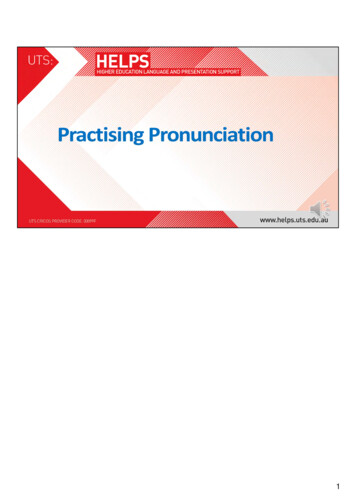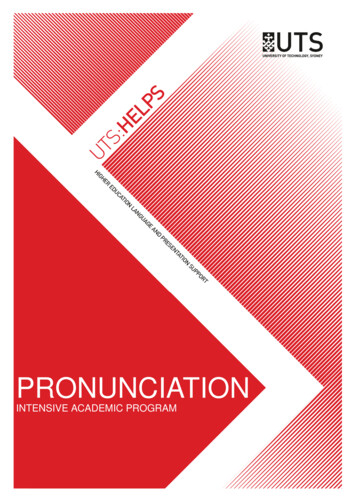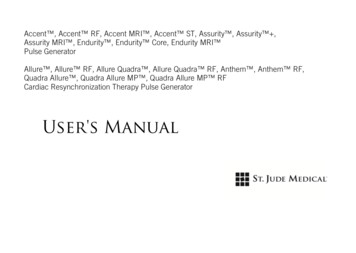
Transcription
Accent Management:From Theory to PracticePart 1 Accent Management TheoryDr. Jenna Luque, CCC-SLP G. Paul Moore Symposium 2021
Jenna Luque, PhD, CCC-SLP Proud UF Alum BA – CSD and Linguistics MA – CSDNorthwestern University MA – LinguisticsUniversity of South Florida PhD – CSD Instructor at USF Sarasota-Manatee Campus 10 years accent management experience Presentations at ASHA and FLASHA Primary research interest Native Advantage, LLC
What is an accent? “Accents are variations in the execution of speechcharacterized by differences in phonological and/or prosodicfeatures that are perceived as different from any native,standard, regional, or dialectal form of speech (Valles, 2015)” “Accents are marked by variations in speech-sound production,prosody, rate, and fluency (Celce-Murcia, Brinton, & Goodwin,1996).” There are different types of accents. Accent Intelligibility Comprehensibility (Derwing and Munro) Not a disorder!Accent Modification. Retrieved from issues/accent-modification/.
What is accent management?What isn’t accent management? Past terms: accent therapy, accent reduction, accent elimination Aka accent modification, pronunciation training It is a way to improve intelligibility It is working on more than just the sounds of the language It is not removing somebody’s accent It is not shaming somebody for having an accent
Why do people seek out accent services? Difficulty being understood Impacting their performance at work Affecting their participation in society Frequently needing to repeat themselves Negative responses/attitudes towards people with accents
Having an accent can be difficult Wei et al. (2012) showed that perceived language discrimination,based on accent, correlated with depression and anxiety Sembiante et al. (2020) discusses the experiences of 5 foreign-bornassistant professors in US universities Awareness of how race/ethnicity and accent index foreignnessReactions to others’ perceptions of foreign accentsNegative judgements of ability or status based on foreign accentPositive judgements of ability or status and privilege based on foreign accentAwareness of and strategic use of flexible language practices Worth (2019) discusses how in England they are discussing makingfederal rules about regional accents
Accent management is not withoutcontroversy. Terminology Not therapy Are they errors? Who should provide/receive these services? Should these services be ordered upon somebody? Should these services even exist?
What does accent management address? Phonemes and Allophones The way they are formed The phonotactics of the language Suprasegmental Information Pitch and IntonationStressLinkingAnd more Idioms, Vocabulary, American Culture
What causes an accent? The mismatch between a speaker’s native language(s) and thelanguage they are learning This can occur at any level of language Let’s unpack this a bit Categorical Perception Speech Perception Models Types of Mismatch
Categorical Perceptionp
Categorical Perception in Real LifeNegative VOTEnglishSpanishThai0Positive VOT
Perceptual Assimilation Model (PAM)Cathy Best When perceiving thedifference between twosounds in a newlanguage, the ease ofdiscrimination dependson how these soundsmap onto the speaker’snative language
Speech Learning Model (SLM)Jim Flege When a sound in the second language is similar to a sound inthe native language, category formation is blocked New sound will resemble native sound Native sound will begin to resemble new sound If a new category is formed in the second language, it and/ornearest existing sound may dissimilate Children are more likely to create new categories than adults
So, how do these contribute to an accent? Categorical perception explains why English learners cannotjust hear English phonemes as they start to learn the language Models like SLM and PAM help explain the specific difficultiesthe learners might have based on the mismatch between theirnative language (L1) and second language (L2)
Let’s talk about mismatch. So far, we have really focused on phonemes, but differencescan occur in other areas. Phonotactic Systems Stress Intonation Vocabulary And more
Transfer from L1 to L2These transfersmay cause anaccent or ameaning change. Italian speaker learning the vowel /ɪ/ in English Mandarin speaker learning a CVC syllable in English English speaker learning Spanish vocabulary Spanish speaker learning /s/-clusters in English Czech speaker learning stress can be non-initial in English French speaker learning English intonation
Model Take Home Models give us a way to predict the difficulties an Englishlearner might have Based on the sound system in their first language Both the sounds they may find difficult and the way in which they makeerrors They are also great ways to explain their difficulties to clients
Influences on Accent Age of Acquisition (AOA) Length of Residence (LOR) L1/L2 use Input Output Motivation Flege’s work
References Accent Modification. Retrieved from ssues/accent-modification/. Best, C. T., McRoberts, G. W., & Goodell, E. (2001). Discrimination of non-nativeconsonant contrasts varying in perceptual assimilation to the listener’s nativephonological system. The Journal of the Acoustical Society of America, 109(2), 775-794. Flege, J. E. (2005). Origins and development of the Speech Learning Model. RetrievedDecember, 13, 2005. Sembiante, S. F., Salinas Jr, C., Ramírez, J. A., Vásquez-Colina, M. D., & Silva, Y.(2020). Different When I Opened My Mouth: Experiences, Reflections, and Perspectivesof Faculty Members with Foreign English Accents in Higher Education. Meridians, 19(2),295-320. Wei, M., Wang, K. T., & Ku, T. Y. (2012). A development and validation of the PerceivedLanguage Discrimination Scale. Cultural Diversity and Ethnic Minority Psychology, 18(4),340. Worth, D. (2019). As a teacher, does your accent matter? Tes magazine.
Accent Management:From Theory to PracticePart 2 Accent Management AssessmentDr. Jenna Luque, CCC-SLP G. Paul Moore Symposium 2021
Assessment Goals Sounds of interest at various levels and positions Don’t forget about vowels!!! Intonation, Stress, Reduction, Timing Language: grammar, vocabulary, idioms? Perception Check for stimulability Overall communication What do they think they need help with?Looking for languagetransfer.
Pre-Assessment Prep Comparison of L1 to English Get an idea of where to expect difficulty Sounds, Intonation, Grammar Wikipedia, Google, textbooks, a friend What information does this give you? How accurate is this information?
Why is perception so important? There is extensive research on non-native speech perception The link between perception and production is not always clear Some evidence suggests, that training perception itself leadsto improved production (Thomson, 2011) Other work shows that production precedes perception (Flege,Bohn, and Jang, 1997)
Client History Understanding their experience with English is incrediblyimportant When and where did they learn/study it? Who taught them? How are they currently using it? Do be cognizant that it is possible for your client to also have acommunication disorder Always ask if there is anything else they want to tell you
Standardized Tests
Compton Phonological Assessment ofForeign Accent (Compton, 1983) After going through the Compton training, you can use these materials Compton Screening Assessment of Foreign Accent 15 words with aa English sounds 3 sentence paragraph Speech sample General observations Full Assessment Background Questionnaire 66 words with all English sounds, initially and finally, twice Produced in isolation and in a spontaneous sentence Spontaneous speech sample phonetic and grammatical errors 15 sentence paragraph Read aloud and then in imitation
Proficiency in Oral EnglishCommunication (POEC) (Sikorski, 1991) POEC – Screener POEC Auditory Discrimination Intonation Articulation
Problems with these Tests Scoring tends to be based on number of errors Effect of reading Lack of morphophonological assessment May require training Yet, they cost money So, what do you do?
My Testing Protocol
I made my own 78 words All sounds in all positions BvD words Clusters Sentences with all sounds “Please call Stella” paragraph Past tense and plural allomorphs Common phrases Multisyllabic words Conversation/Background Information
Word Level
Sentence Level
Paragraph
Grammatical Allomorphs
Common Phrases
Multisyllabic Words
Conversation/Background Information Goal: get them talking Ask questions about their language background Get to know them Get them to tell you stories Listen for the same things we have been looking for at theconversational level
References Compton, A.J. (1983). Compton Phonological Assessment of Foreign Accent. Las Vegas, NV: WideWorld, Ltd. Flege, J. E., Bohn, O. S., & Jang, S. (1997). Effects of experience on non-native speakers' productionand perception of English vowels. Journal of phonetics, 25(4), 437-470. Sikorski, L. (1991). Proficiency in Oral English Communication Manual. Santa Ana, CA: LDS &Associates. Tessel, C.A. (in press). Accent Modification-(to be Chapter 15). In Articulation and PhonologicalDisorders: Speech Sound Disorders in Children (to be in 9th edition). Maryland: Brookes. Thomson, R. I. (2011). Computer assisted pronunciation training: Targeting second language vowelperception improves pronunciation. Calico Journal, 28(3), 744-765. Tsukada, K., Birdsong, D., Bialystok, E., Mack, M., Sung, H., & Flege, J. (2005). A developmental studyof English vowel production and perception by native Korean adults and children. Journal ofPhonetics, 33(3), 263-290.
Accent Management:From Theory to PracticePart 3 Accent Management TreatmentDr. Jenna Luque, CCC-SLP G. Paul Moore Symposium 2021
Something to keep in mind These are adults with total knowledge of anotherlanguage/sound system They may not know phonetics, but they have knowledge baseto work from Once they know place, manner, and voicing – they will make somesense of their native language They can also reason well and have control over theirarticulators
Setting Goals Collaborative process Things to consider Biggest impact Ease of accomplishment Ease of teaching Consider level to target Balance segmental and suprasegmental targets
Treatment Approaches
Pre-Treatment Training Accent clients come from varied backgrounds in terms of theirEnglish language education Ensuring common knowledge/vocabulary allows the everythingelse to continue smoothly There is not a lot of research on this, but I am working in it
Segmental Instruction – Motor-based Imitation Articulatory Cues Visual Models Isolation Syllable Reading Conversation
Segmental Training – Phonological-based Recent work has suggested approaching accent work as we dophonological disorders in children could work Some of the same “phonological processes” occur (Franklin andMcDaniel, 2016; Tessel and Luque, 2020) Minimal Pair Approach Cycles Approach
Prosodic Instruction Stress Sentence vs. question intonation Linking Speech Rate Clear Speech Differences in native vs. non-native clear speech (Smiljanic andBradlow, 2005; Rogers, DaMasi, and Krause, 2010; Luque andBradlow, 2011) One study looked at this an instruction approach (Behrman, 2017)
Segmental vs. Prosodic Is more effective to choose one approach over the other?
Biofeedback Biofeedback shows the client a representation of their speech Used as a comparison Manipulated to learn how to move articulators Acoustic Feedback Praat (Boersma and Weenik, 2021) Computerized Speech Lab (CSL) (KayPentax) WASP (Waveforms, Annotations, Spectrograms, Pitch) (Huckvale,2016) UltrasoundWilson, I. (2014). Using ultrasound for teaching and researchingarticulation. Acoustical Science and Technology, 35(6), 285-289.
Group Treatment Benefits Partner work Peer models Difficulties Different language backgrounds Juggling many people Compton does have a curriculum
My Treatment Approach
The Three Senses
The Three Senses From PAM, we know that some sounds are difficult todiscriminate This is why saying /ɪ/, not /i/, will not usually work This is also why self-monitoring will be difficult So add in sight and touch Certain sounds work better with each
Tips for Using Sight ALWAYS have a mirror present Lip shape, tongue protrusion, movement For telepractice, they can usually see themselves in the chat program Some clients will fight you on this What else can you see? Pitch track Voicing bar
Tips for Using Touch Some people can’t feel what their mouth is doing So start with their native language Enhance the feeling Lollipop, ice cube, pencil Have them move their articulators with their hands, orsomething else
Remember . Accent modification is a type of articulation therapy, so if youhave a trick in that arena – try to apply it here Same principals of scaffolding and finding a facilitative context
Vowels Four things to focus on Lip shape Smile Round Open Tongue Height Tongue Backness Movement (Diphthongs)**Don’t forget things like tongue rounding also**
Specific Vowels beat, bit, bet How much space should be between the teeth? boot, book Tight vs. Duck Face Use a jawbreaker Transition from /ʃ/ cot, caught Does this matter?
Consonants Three things to focus on Voicing Place Manner
Specific Consonants /r/ Close your mouth Different types of r’s /ŋ/ Do they know it exists? Transition from k or g /l/ Point out the visual of contact with the alveolar ridge
Tools I Have Used Praat Free software that allows you to see that acoustic properties of speech I have given a whole talk on just this before, so today is just a briefmention Speech Buddies/Language Buddies
Praat Created by linguists in The Netherlands Very powerful, but you can just use parts of it Download for free at www.praat.org
How to Read a SpectrogramY-Axis: FrequencyVolume DarknessX-Axis: Time
Pitch
Final Voicing
s/ʃ Noticelocation ofenergy
Speech Buddies The Speech Buddy, designed by Articulate Tech, is atool that gives consistent tactile feedback for difficultspeech sounds The Speech Buddy is designed to guide tongue placement forlanguage learners The full set contains 5 target sounds (/r, l, s, ʃ, tʃ/)
Speech Buddy - R
Speech Buddy - L
Our Study Conducted at Northwestern University Using 9 English learnersFocused on /r/ and /l/Pre- and Post-Recordings, with at home practice protocolQuantitative data supported use of Speech BuddyQualitative: 6/6 said they would recommend the tool to a friendLuque, Leddon, and Moore (2013)
Quotes from Participants The program required a lot of commitment, but patience willpay off. The distinction between R and L is the most difficult thing inmy English learning. Thanks to the Speech Buddy, I feelmore confident with those pronunciations than before. At first you may feel tired of using the Speech Buddy, butyou will be excited when you see the improvement ofyour pronunciation as time goes on. The tool can help me find the right position for the tongue.
References Behrman, A. (2017). A clear speech approach to accent management. American Journal of Speech-Language Pathology, 26(4), 1178-1192. Boersma, Paul & Weenink, David (2021). Praat: doing phonetics by computer [Computer program]. Version 6.1.38, retrieved 2 January 2021 fromhttp://www.praat.org/ Compton, A.J. (2008). Pronouncing English as a Second Language. Wide World Ltd. Franklin, A., & McDaniel, L. (2016). Exploring a phonological process approach to adult pronunciation training. American Journal of Speech-Language Pathology,25(2), 172-182. Huckvale, M. (2016). WASP program [Computer program]. Version 1.80, retrieved 27 January 2021 from http://www.speechandhearing.net/ Luque, J.S. and Bradlow, A.R. “Clear speech production by nonnative English speakers.” Presented at the 162nd Meeting of the Acoustical Society of America, SanDiego, CA, 2011 Luque, J., Leddon, E., and Moore, J. “Tactile Intervention for Accent Modification – Speech Buddies.” Presented at the American Speech and Hearing AssociationAnnual Convention, Chicago, IL, 2013 Rogers, C. L., DeMasi, T. M., & Krause, J. C. (2010). Conversational and clear speech intelligibility of/bVd/syllables produced by native and non-native Englishspeakers. The Journal of the Acoustical Society of America, 128(1), 410-423. Smiljanić, R., & Bradlow, A. R. (2005). Production and perception of clear speech in Croatian and English. The Journal of the Acoustical Society of America, 118(3),1677-1688. Tessel, C. A., & Luque, J. S. (2020). A comparison of phonological and articulation-based approaches to accent modification using small groups. Speech, Languageand Hearing, 1-14. Turner, J., & Gutierrez, A. (2013). Pronunciation Training Needs for Chinese and Korean Interpreters-in-Training. Perspectives on Communication Disorders andSciences in Culturally and Linguistically Diverse (CLD) Populations, 20(3), 90-100. Warner, J.L. (Producer), & Cukor, G. (Director). (1964). My Fair Lady [Motion Picture]. United States of America: Warner Brothers.
Past terms: accent therapy, accent reduction, accent elimination Aka accent modification, pronunciation training It is a way to improve intelligibility It is working on more than just the sounds of the language It is not removing somebody’s accent It is n










